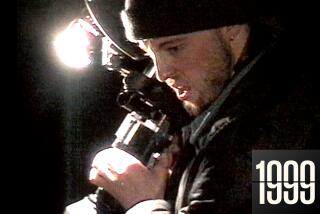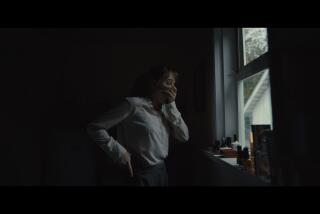‘Deliver Us From Evil,’ ‘The Strain,’ and selling modern horror
Advertising campaigns are designed to get eyeballs, but apparently you can sometimes take that mandate a little too literally.
This week the FX cable network started pulling down some billboards for director Guillermo del Toro’s upcoming vampire-horror series “The Strain” amid protests that the ads — which show a worm coming out of an eyeball — are too gross and disturbing. “Hey, ‘The Strain’ billboards,” “Neighbors” director Nicholas Stoller tweeted, “people have little kids in this city who don’t want to be scared out of their.....minds!”
The flap revealed some of the unique dilemmas that go along with marketing the horror genre in the 21st century. On the one hand, you want to get the word out as widely as possible that your movie — or, in the case of “The Strain,” your TV series — is genuinely horrifying. On the other hand, there are many people who may not appreciate being confronted with nightmarish imagery, say, on their way to pick up a carton of milk.
In recent years, that marketing challenge has only gotten trickier. In today’s post-“Saw” world, wide-release horror films routinely feature levels of graphic gore that would have been considered beyond the pale of mainstream frightfests a few decades ago. That may delight the sort of people who regularly peruse Fangoria magazine, but it presents a conundrum to those trying to sell the grisliness to the masses. Not to mention that audiences have grown so familiar with many of the standard tropes of the modern horror genre — the faux found footage, the gruesome torture schemes, the possessions and exorcisms — that it’s become harder to get their attention.
As a result, horror marketers have been forced to get more creative. The promotional campaign for last year’s “Carrie” remake, for example, featured an elaborate viral video in which patrons at a coffee shop were fooled into thinking that a customer was having a Carrie White-style telekinetic freakout and hurling around tables, chairs and people with her mind. The onlookers’ shocked reactions were surreptitiously filmed, and when the resulting video hit YouTube, it received over 4 million hits in a single day.
Similarly, the campaign for January’s “Devil’s Due” featured a “Candid Camera”-esque prank in which a remote control baby carriage was parked on various street corners in New York and the sounds of a baby’s cries were piped out of it. When well-meaning passersby approached to look, a demonic animatronic baby popped out to scare the bejesus out of them. That’ll teach them to be concerned about distressed, abandoned infants.
With its new film “Deliver Us From Evil,” which opens Wednesday, Screen Gems is trotting out another gambit that has been used in a number of recent horror campaigns. One TV spot for the film shows footage of moviegoers watching the film and reacting with gasps and screams. Aside from a few quick-cut glimpses — a child saying something creepy, a car window being smashed — almost nothing from the actual movie is shown. But the ad gives the impression that something truly terrifying must be happening onscreen to elicit such horrified reactions.
It’s reasonable to ask whether the sight of random people screaming will actually make someone more inclined to want to head to their local multiplex. It’s also reasonable to ask whether, with some of these films, more creativity hasn’t gone into the advertising campaigns than into the actual movies. Still, the horror genre continues to deliver predictable, consistent results at the box office — the modestly budgeted “Deliver Us From Evil” is likely to gross in the neighborhood of $20 million for the five-day weekend — and as long as that’s the case, marketers will keep trying to find new ways to lure in audiences.
Just maybe not with eyeballs next time.
Follow @joshrottenberg for more movie news
More to Read
Only good movies
Get the Indie Focus newsletter, Mark Olsen's weekly guide to the world of cinema.
You may occasionally receive promotional content from the Los Angeles Times.











